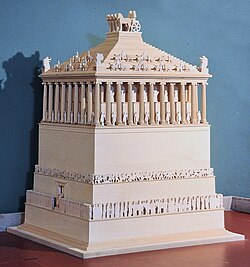The Seven Wonders of the Ancient World: Mausoleum at Halicarnassus (Turkey)
The Mausoleum at Halicarnassus: A Marvel of Ancient Architecture
Introduction
Nestled in the ancient city of Halicarnassus, present-day Bodrum in Turkey, the Mausoleum at Halicarnassus stands as a testament to the grandeur and artistic prowess of the ancient world.
Commissioned by Mausolus, the satrap of Caria, as his final resting place, this monumental tomb captivates with its majestic design and rich historical significance.
From Wikipedia, the free encyclopaedia
Mausoleum of Halicarnassus
Model of the Mausoleum at Halicarnassus, at the Bodrum Museum of Underwater Archaeology.

Location within Turkey
The Mausoleum at Halicarnassus or Tomb of Mausolus[a] (Ancient Greek: Μαυσωλεῖον τῆς Ἁλικαρνασσοῦ; Turkish: Halikarnas Mozolesi) was a tomb built between 353 and 350 BC in Halicarnassus (present Bodrum, Turkey) for Mausolus, an Anatolian from Caria and a satrap in the Achaemenid Empire, and his sister-wife Artemisia II of Caria. The structure was designed by the Greek architects Satyros and Pythius of Priene. Its elevated tomb structure is derived from the tombs of neighbouring Lycia, a territory Mausolus had invaded and annexed c. 360 BC, such as the Nereid Monument.[3]
The Mausoleum was approximately 45 m (148 ft) in height, and the four sides were adorned with sculptural reliefs, each created by one of four Greek sculptors: Leochares, Bryaxis, Scopas of Paros, and Timotheus.[4] The Mausoleum contained total 400 freestanding sculptures. The mausoleum was considered to be such an aesthetic triumph that Antipater of Sidon identified it as one of his Seven Wonders of the Ancient World. It was destroyed by successive earthquakes from the 12th to the 15th century; it was the last surviving of the six destroyed wonders.
The word mausoleum has now come to be used generically for an above-ground tomb.
Historical Context
The Mausoleum at Halicarnassus was constructed between 353 and 350 BCE, following the death of Mausolus. Designed by renowned architects Satyros and Pythius, the mausoleum was intended to be a lasting tribute to Mausolus and his accomplishments as a ruler.
It served as a symbol of his power and wealth, as well as a testament to the enduring bond between him and his wife, Artemisia II of Caria.
Architectural Splendour
The Mausoleum at Halicarnassus was a masterpiece of ancient architecture, blending elements of Greek, Lycian, and Egyptian styles. Rising over 45 meters (148 feet) in height, the mausoleum featured a rectangular base adorned with intricate friezes and sculptural reliefs depicting mythological scenes, battles, and deities.
Above the base stood a series of Ionic columns supporting a pyramid-shaped roof crowned by a colossal sculpture group, including a quadriga chariot.
Cultural Significance
Beyond its function as a tomb, the Mausoleum at Halicarnassus served as a symbol of cultural and artistic achievement in the ancient world.
Its construction marked a milestone in the development of monumental architecture, influencing subsequent mausolea and monuments across different civilizations.
The mausoleum also became a tourist attraction and a centre of religious pilgrimage, drawing visitors from far and wide to marvel at its grandeur.
Legacy and Influence
Although the Mausoleum at Halicarnassus was partially destroyed by earthquakes and plundered for its marble and stone over the centuries, its legacy endures as one of the Seven Wonders of the Ancient World.
Its influence can be seen in later architectural works, including Renaissance and neoclassical monuments that drew inspiration from its design and proportions.
Conclusion
The Mausoleum at Halicarnassus stands as a testament to the artistic, cultural, and historical achievements of the ancient world. Despite the passage of time and the ravages of nature, its memory continues to captivate the imagination of scholars, historians, and travellers alike.
As a symbol of human ingenuity and creativity, the mausoleum serves as a reminder of the enduring legacy of civilizations long gone, inspiring wonder and admiration for generations to come.
References
- Kostof, Spiro (1985). A History of Architecture. Oxford: Oxford University Press. p. 9. ISBN 0-19-503473-2.
- Gloag, John (1969) [1958]. Guide to Western Architecture (Revised ed.). The Hamlyn Publishing Group. p. 362.
- André-Salvini, Béatrice (2005). Forgotten Empire: The World of Ancient Persia. University of California Press. p. 46. ISBN 978-0520247314.
- Smith, William (1870). "Dictionary of Greek and Roman Antiquities". p. 744. Archived from the original on 18 June 2006. Retrieved 21 September 2006.
- "National Geographic – How this massive tomb became a wonder of the ancient world". Zegister. 2 January 2023. Retrieved 3 January 2023.
- "Mausoleum of Halicarnassus". ancienthistory.about.com. Archived from the original on 21 February 2014. Retrieved 5 February 2014.
- "The Mausoleum at Halicarnassus". unmuseum.org. Retrieved 5 February 2014.
- "The Mausoleum of Halicarnassus". bodrumpages.com. Retrieved 5 February 2014.
- Colvin, Howard (1991). Architecture and the after-life (1st ed.). Yale University: New Haven Press. pp. 30–31. ISBN 978-0300050981.
- Fergusson, p. 10.
- A. Luttrell, The later history of the Maussolleion and its utilization in the Hospitaller castle at Bodrum. In Kristian Jeppesen, et al. The Maussolleion at Halikarnassos. 1986.
























































